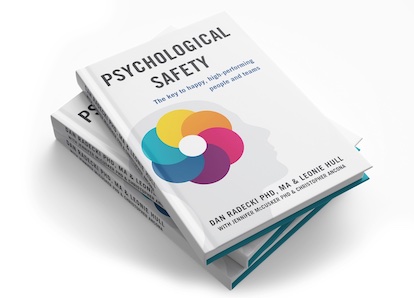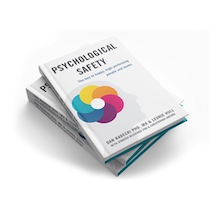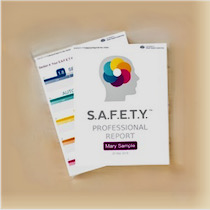As the Nation’s Doctor, the Surgeon General’s office provides Americans with the best scientific information available on how to improve their health and reduce their risk of illness and injury. It’s gratifying to see that this institution is now advocating for the importance of mental well-being and psychological safety in our workplace setting. Recently, the office released The Surgeon General’s Framework for Workplace Mental Health and Well-Being, which emphasizes the connection between the well-being of workers and the health of organizations and suggests a data-driven approach that can be used as a foundation in workplace settings of any type or size or. The model focuses on driving sustainable change through engaged leaders who value and collaborate with their workers in establishing a healthy, psychologically safe culture.
Some of the statistics are sobering. 84% of participants polled stated at least 1 workplace factor that negatively impacted their mental health, with 56% of those reporting burnout as the most common symptom. The result of this impact has been felt in terms of turnover, where 50% of respondents stated that they’ve left a job in the past year due to, at least in part, mental health reasons. This number jumps to 81% in Generation Z respondents, which highlights the specific negative impact on the emerging workforce. Not surprisingly, the framework put forth by the Surgeon General’s Office stresses the importance of creating a psychologically safe space, where open collaboration and vulnerability can create a true sense of belonging where employees feel motivated and as though they are contributing in a meaningful manner. Interestingly, this framework is rooted in many of our S.A.F.E.T.Y.™ domains, which makes sense when you consider these domains to be the driving needs behind individual psychological safety. So, what did they find in their research? The framework focuses on enhancing workplace mental health and well-being through workplace equity and autonomy. They propose Five Essentials of well-being and suggest ways to create practices to make these essentials come to life:
1. Protection from Harm
The first framework focuses on the human need for security and safety, calling out psychological safety as a key component. This may not be surprising, considering the recent work around the importance of having our emotional/social stressors managed, but this elevates the idea of psychological safety to be on par with that of physical safety. This aligns perfectly with the “S” (security) in the S.A.F.E.T.Y.™ Model, where the brain treats physical and social threats in much the same way, and therefore, both need to be prioritized in any discussion about well-being.
2. Connection and Community
The second Essential of the Framework is Connection and Community, which deals with building authentic, positive social interactions and relationships. This Essential specifically focuses on social support and well-being and operationalizes inclusion and belonging by enhancing trust across the organization. Again, this reflects the “T” (Trust) S.A.F.E.T.Y.™ domain. Our brains are wired to be tribal, where we relate best to those who are likable or similar to us and tend to relegate to the “out group” those who aren’t. Organizations need to be intentional in helping employees overcome this natural “in vs out group” bias so that genuine trust can exist. While the framework doesn’t go into much detail around the “how” to do this, we have developed the T.R.A.I.N.™ Process to specifically address the issue around HOW to manage these biases.
3. Work-Life Harmony
This Essential addresses the need to create autonomy and flexibility in employees, in order to optimize mental well-being. From the “A”(Autonomy) in the S.A.F.E.T.Y.™ Model, We know from neuroscience research that autonomy is a key need for our brain, and when not met can lead to not only psychological distress but physical manifestations such as hypertension and pain. This Essential also suggests the need for predictability in the daily activities of an employee in order to, again, appease the brain’s need for security. They state that …. unpredictable scheduling is linked to increased income volatility, an increased risk of economic hardship, which can degrade physical and mental health. Schedule irregularity among workers can also lead to work-life conflicts that negatively affect relationships both in and out of the workplace, including behavioral and mental health challenges in children of working parents”.
4. Mattering at Work
People want to know that they matter to those around them and that their work has personal value, as this sense of meaning has been shown to lower stress, while feeling like you do not can raise the risk for depression. This need for meaning is also tied to recognition within the framework, since when people are recognized by their supervisors and co-workers, their sense of value and meaning increases, as well as their ability to manage stress. This is exactly the foundation behind the “E” (Esteem) S.A.F.E.T.Y.™ domain, where research has shown that our brains’ threat response is magnified when we don’t feel we are adequately recognized or, worse yet, feel unjustly rejected.
5. Opportunity for Growth
The final Essential of this Framework is based around creating opportunities for workers to accomplish goals based on their skills and growth. Crucial to this Essential is that a sense of fairness is put forth as a priority across the organization in this regard. The “F” (Fairness) domain in the S.A.F.E.T.Y.™ Model speaks nicely to this, as our brain revolts when we sense that we aren’t being treated equitably. In fact, we activate the area of our brain that deals with the powerful emotion of disgust when we perceive unfairness in our world. So obviously establishing a fair, just culture in terms of employee opportunities, is critical to building well-being.
Increasingly, more organizations and government agencies, like the Surgeon General, are recognizing the importance of psychological safety for our overall emotional, cognitive, and physical well-being. The Academy of Brain-based Leadership has identified the neurobiological foundations of this 8 years ago and has created an assessment to help you understand your individual psychological safety needs, and models to manage these stress triggers when they arise. If you’d like to learn more about how we’ve helped tens of thousands of individuals manage their well-being through awareness of their psychological safety triggers and the science-based strategies to manage them, visit brainleadership.com.













